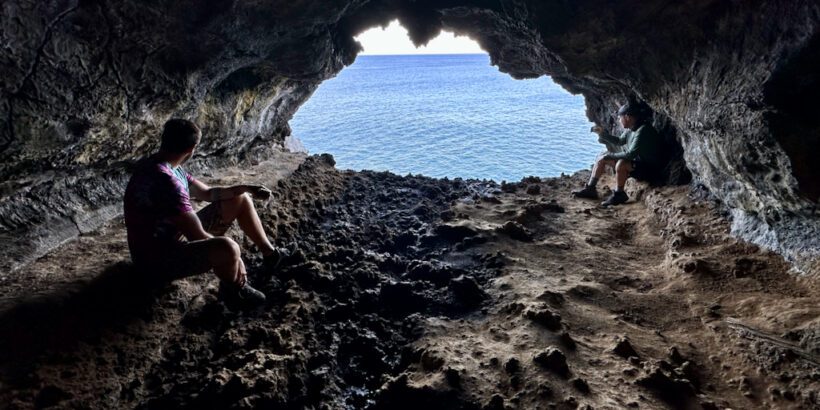When people think of Easter Island (Rapa Nui), their minds often go straight to the mysterious moai—the towering stone statues that line the island’s windswept slopes. But beneath the volcanic soil of this remote Pacific outpost lies an equally fascinating world: an underground network of caves.
Carved by ancient lava flows and shaped over thousands of years, the caves of Easter Island are not only geological wonders but also windows into the lives, beliefs, and survival strategies of the Rapa Nui people.
The Geology Behind the Caves
Easter Island was shaped by volcanic activity, thanks to three now-extinct volcanoes: Terevaka, Poike, and Rano Kau.
When these volcanoes erupted, the lava didn’t just pile up into hills and craters—it also formed long, hollow tunnels underground. These are called lava tubes, and they happen when the surface of a lava flow cools and hardens, while the molten lava underneath keeps moving. Once the flow stops, you’re left with a natural tunnel.
Most of the caves on Easter Island formed this way. Compared to caves carved out by water (like in limestone), lava tube caves are usually narrower, more tube-shaped, and surprisingly sturdy. That made them perfect for people to use—for shelter, storage, and even ceremonies.

How Many Caves Are on Easter Island?
No one knows the exact number, but archaeologists believe there are somewhere between 800 and 1,000 caves scattered across Easter Island. A lot of them are small or tucked away in hard-to-reach places, but researchers have found signs that many of these caves were definitely used by people—whether for shelter, storage, rituals, or hiding out.
Most of the caves are concentrated in the northern and southwestern parts of the island, where the lava flows were especially active long ago. Some of these underground tunnels stretch for more than 7 kilometers (about 4.3 miles), making them some of the longest lava tubes anywhere in the Pacific.
Sacred Spaces, Secret Shelters
For the Rapa Nui, caves served a lot of different purposes including:
- Shelter and Refuge: During times of conflict or famine, caves offered protection and a hidden place to live.
- Food Storage: Their cool, stable temperatures made caves ideal for storing staples like sweet potatoes and yams. Some still have carved storage pits.
- Burials and Rituals: Certain caves held spiritual meaning. Archaeologists have found bones, offerings, and carvings, pointing to their use in religious practices.
- Art and Symbols: Many caves display rock art—birds, fish, human figures, and the iconic Birdman motif—marking them as places of cultural expression.
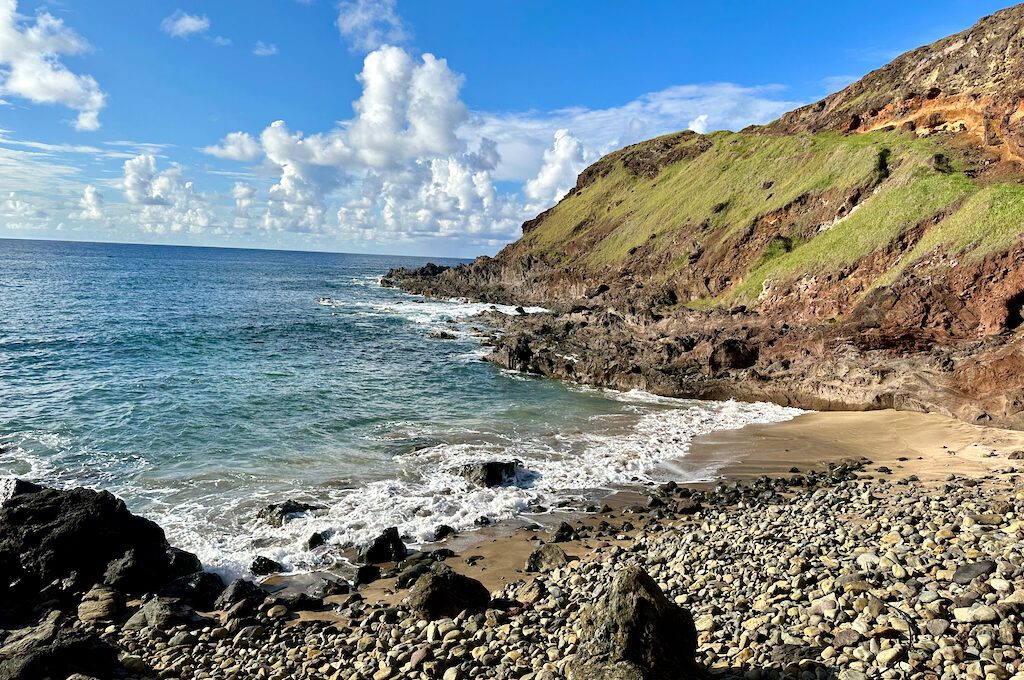
Notable Caves of Easter Island
Some caves on the island really stand out—whether because of their massive size, historical importance, or just plain stunning views. On our visit, we explored three in particular: Ana Te Pahu; Ana Kakenga; Ana Kai Tangata.
But there are countless others tucked across the island—many hidden, unmarked, or only known to locals and guides. Each one adds a new piece to the story, and it’s easy to see how the underground world of Rapa Nui was just as vital as what stood above.
Ana Te Pahu (The Banana Cave)
Near the base of Terevaka volcano, Ana Te Pahu is one of the largest and best-known lava tubes on Easter Island. It gets its nickname—the Banana Cave—from the banana trees growing near the entrance, fed by the cave’s natural moisture. Inside, the cave has multiple chambers and was once used for both living space and food storage.
Because it’s such a popular stop, our guide actually decided to skip this one and take us somewhere different. Just a short walk away, he led us to a hidden cave—one that isn’t marked and is hard to spot unless you know exactly where to look.
We ducked inside, crawled through narrow passages, and followed it deeper underground. At one point, the ceiling got so low we were almost belly-crawling, and eventually we reached a small underground pool of water. It was pitch-black, cool, and completely silent—definitely not part of the usual tour, and easily one of the most unforgettable moments of the trip.
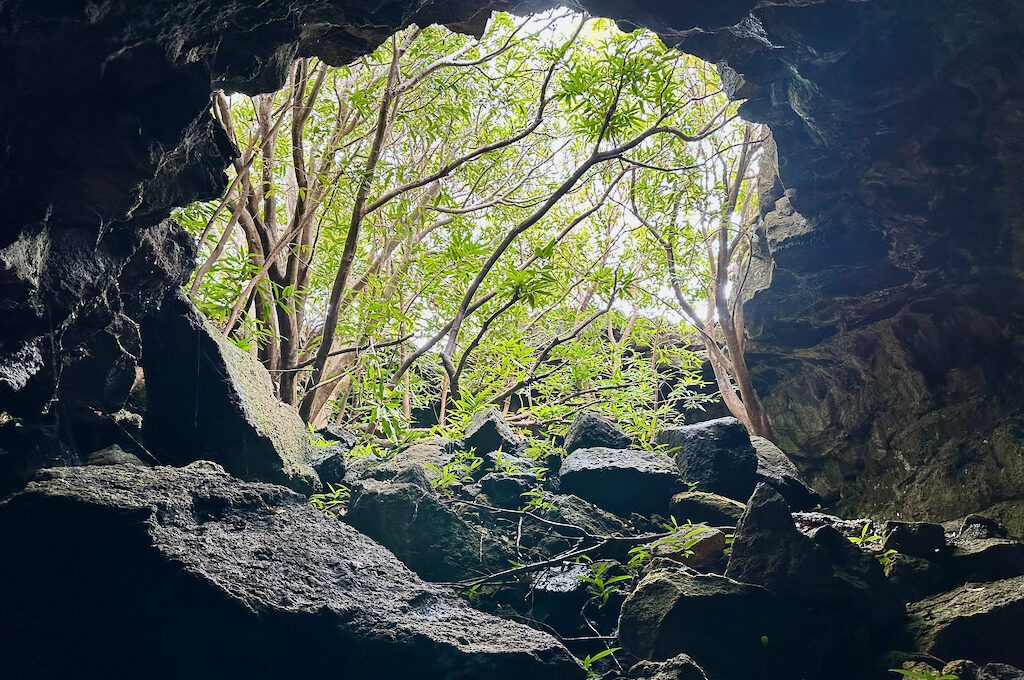
Ana Kakenga (The Cave of the Two Windows)
This might be the most photogenic cave on the island. Ana Kakenga is a lava tube that ends in two cliffside openings—natural “windows” that look straight out over the vast Pacific Ocean. It’s easy to see why this spot is such a favorite: the view is dramatic, wild, and humbling. Historically, it’s said the cave was used as a hiding place during times of conflict, thanks to its hard-to-spot entrance and rugged terrain.
Getting there involves a hike—not too tough, but it does take you across an uneven volcanic landscape. The ground is rocky and jagged in places, so it’s the kind of trail where you need to watch your step. Definitely a place where you could twist an ankle if you’re not paying attention. But the walk itself is beautiful. As you hike, you get sweeping views of the ocean, and if you’re lucky, you might see people out training for rowing competitions or even spot whales in the distance.

Eventually, you’ll come to what looks like a small hole in the ground. That’s the entrance. It’s a tight squeeze at first, but once you’re inside, the tunnel opens up and becomes easier to move around in. There are a couple of different paths inside, but the real payoff is when you reach the part that opens straight out onto the cliff. You’re standing inside a lava tube, carved by nature, staring out at nothing but endless ocean—a reminder of how small this little island is, and how massive the Pacific really feels.
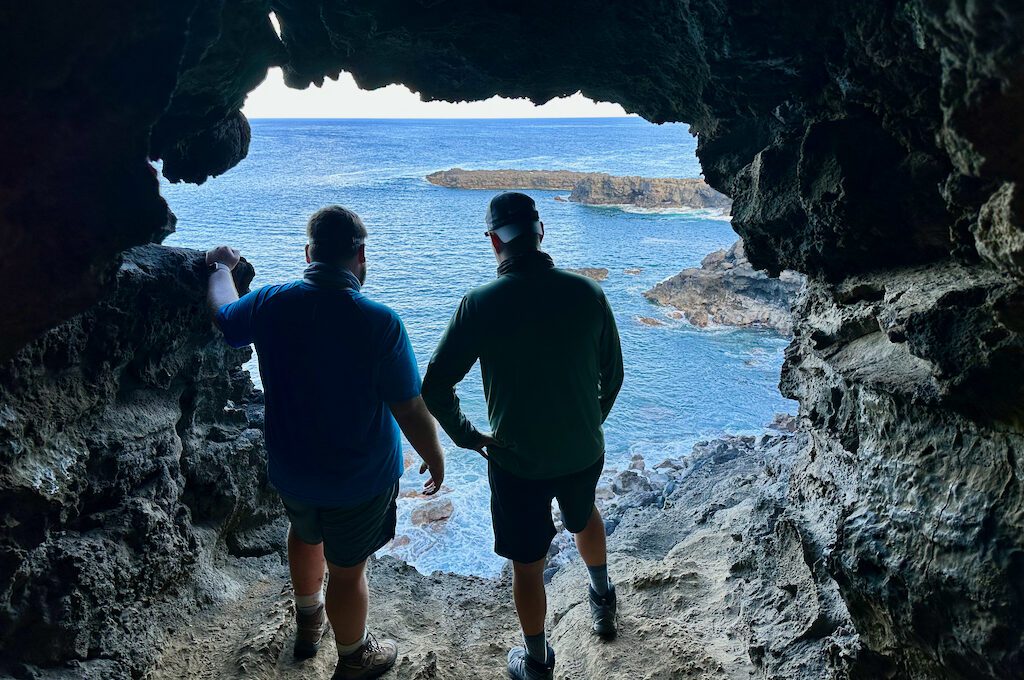
Ana Kai Tangata
Just south of Hanga Roa, this large seaside cave is one of the few places on the island where you can still see ancient rock paintings up close. On the cave’s ceiling, you’ll find faded images in red, black, and white, mostly of sooty terns (manutara)—birds that played a big role in the island’s Birdman religion.
The name Ana Kai Tangata has been translated as “Cave of the Cannibals”, which adds an eerie edge to the visit. Some oral histories mention cannibalism during times of extreme famine, though there’s no solid evidence tying this cave directly to that.

To get down to the cave, you’ll take a mix of stone steps and maybe a little bit of rock scrambling toward the bottom. The cave is large and open to the ocean, so there’s this constant sound of waves crashing that adds to the atmosphere. The rock art is pretty faded now, but if you take your time, you can still spot some of the designs clearly.
Knowing the stories linked to the cave—especially the possible connections to survival during hard times—makes exploring it feel a little haunting, but also fascinating. And since it’s right on the water, it’s just a beautiful place to take your time in. There are also a few coastal overlooks nearby, so it’s worth wandering the area a bit after your visit.
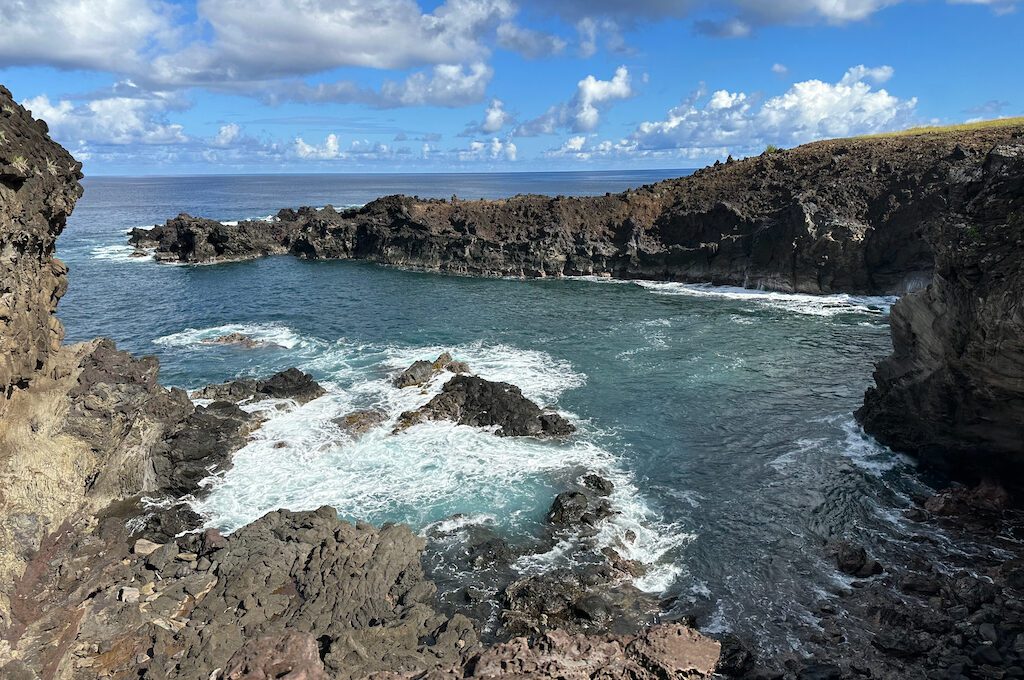
A Hidden Layer of History
The moai statues might be the first thing people think of when they picture Easter Island, but the island’s real stories run deeper—literally. The caves here were more than just holes in the ground—they were places to live, store food, hide during hard times, and even connect with something spiritual. They helped the Rapa Nui people survive and make sense of their world, all while living in one of the most remote places on Earth.
Whether you’re looking up at the faded rock art in Ana Kai Tangata or standing inside Ana Kakenga, staring out at the endless Pacific, the caves give you a different perspective on the island—one that feels more personal and human. It’s a reminder that not all of Easter Island’s history stands tall in the open. Some of it is tucked away underground, waiting to be explored.
Daniel Gillaspia is the Founder of UponArriving.com and the credit card app, WalletFlo. He is a former attorney turned travel expert covering destinations along with TSA, airline, and hotel policies. Since 2014, his content has been featured in publications such as National Geographic, Smithsonian Magazine, and CNBC. Read my bio.

